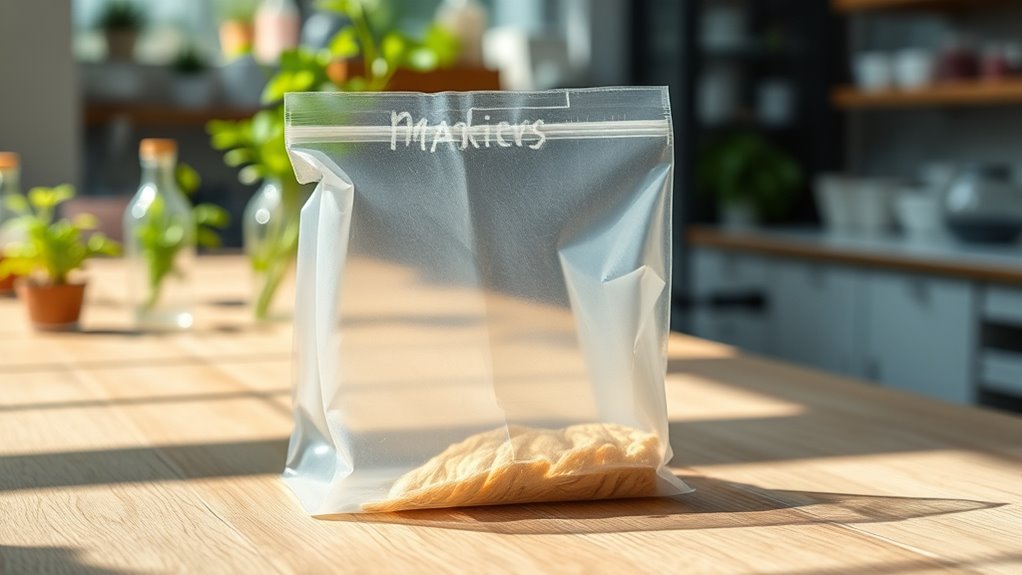Bio‑based polyurethane (PU) shows promising potential to replace fossil-fuel plastics in bags, thanks to its environmental benefits, biodegradability, and comparable performance. While current production costs and manufacturing challenges slow wider adoption, ongoing innovations are improving durability and scalability. As industry trends shift toward sustainability and regulations favor eco-friendly materials, bio-PU could become a mainstream choice. Keep exploring how advances are shaping its future and how it may revolutionize packaging solutions.
Key Takeaways
- Advances in bio-based PU formulations improve durability, flexibility, and biodegradability, making them increasingly suitable for bag production.
- Technological innovations and economies of scale are reducing production costs, enhancing commercial viability for replacing fossil-fuel plastics.
- Regulatory incentives and consumer demand for sustainable products are driving industry shifts toward bio-based alternatives in packaging.
- Challenges remain in raw material supply, processing scalability, and performance consistency, requiring ongoing research and development.
- The environmental benefits of bio-based PU, including lower emissions and faster biodegradation, support its potential to substitute traditional plastics in bags.
Understanding Bio‑Based Polyurethane: Composition and Production

Bio-based polyurethane (PU) is a sustainable alternative to conventional PU that uses renewable raw materials. Its core lies in biopolymer synthesis, where natural resources like plant oils or lignocellulosic biomass are transformed into polymers. The process begins with sourcing raw materials responsibly—such as vegetable oils, which serve as the primary feedstock. These oils undergo chemical reactions to create polyols, essential components of PU. The synthesis continues with the combination of these polyols and isocyanates, resulting in a durable, flexible material. By carefully sourcing renewable raw materials, you guarantee the sustainability of the production process. This approach not only reduces reliance on fossil fuels but also aligns with eco-friendly manufacturing practices essential for the future of bio-based PU. Additionally, advancements in sustainable sourcing are helping to further improve the environmental profile of bio-based polyurethane. Incorporating circular economy principles can also enhance resource efficiency and reduce waste in production. Moreover, ongoing research into renewable raw material utilization is paving the way for even more sustainable manufacturing methods. As the industry progresses, the development of biodegradable polymers offers promising solutions for reducing plastic waste and environmental impact.
Environmental Benefits of Switching to Bio‑Based PU

Switching to bio-based polyurethane helps you reduce your carbon footprint considerably. It also offers the advantage of biodegradability, making it more eco-friendly at the end of its life cycle. Plus, it emits lower levels of toxic substances during production, supporting a healthier environment. Additionally, sustainable materials like bio-based PU are designed to lessen reliance on fossil fuels, further promoting environmental conservation. Incorporating eco-friendly materials can also improve corporate sustainability credentials and appeal to environmentally conscious consumers. Techniques such as track development can help optimize the use of bio-based PU in manufacturing, ensuring better performance and environmental benefits. Recognizing that creativity thrives within limitations, exploring innovative ways to utilize bio-based PU under specific constraints can lead to more resourceful and effective solutions.
Reduced Carbon Footprint
By adopting bio-based polyurethane (PU), you can substantially reduce your carbon footprint compared to traditional petroleum-based options. Bio-PU production typically involves lower greenhouse gas emissions, as it uses renewable resources rather than fossil fuels. Lifecycle analysis shows that bio-based materials generate fewer emissions from manufacturing to disposal. Although recycling challenges exist with some bio-based plastics, advancements are making recycling more feasible. These processes help minimize overall environmental impact, reinforcing bio-PU’s sustainability benefits. Additionally, innovations in recycling technologies are improving the ability to reuse bio-based plastics, further enhancing their environmental advantages. The integration of AI-powered data analytics in manufacturing processes is also helping optimize resource use and reduce waste, supporting sustainability efforts. Moreover, using biodegradable materials can decrease the accumulation of persistent plastics in the environment. Incorporating circular economy principles into production and disposal strategies is vital for maximizing environmental benefits. By choosing bio-based PU, you’re supporting a product that contributes less to climate change, helping you meet eco-friendly goals. Reducing carbon footprint isn’t just about emissions; it involves considering the entire lifecycle, as renewable resources play a key role in lowering overall environmental impact.
Biodegradability Advantages
Have you considered how your choice of materials impacts the environment after disposal? Bio-based PU offers significant biodegradability advantages, helping reduce long-term waste. Unlike traditional plastics, it breaks down more quickly, lessening environmental pollution. However, biodegradability doesn’t mean it’s free from challenges. Recycling challenges remain because bio-based PU can be incompatible with existing recycling streams, complicating waste management. Additionally, durability concerns might arise if the material degrades too fast in certain conditions, affecting product lifespan. Despite these hurdles, bio-based PU’s potential to decompose naturally makes it a more eco-friendly option. By choosing bio-based PU, you support a more sustainable future, reducing landfill accumulation and environmental impact. It’s a promising step toward greener packaging solutions, aligning durability with environmental responsibility.
Lower Toxic Emissions
Choosing bio-based polyurethane not only benefits the environment through its biodegradability but also considerably reduces toxic emissions during production and use. Unlike synthetic alternatives, which release harmful chemicals, bio‑based PU emits fewer toxic fumes, making it safer for workers and communities. This reduction is especially important given the recycling challenges faced by traditional plastics, which often release toxic substances when processed or discarded. Switching to bio‑based PU helps cut down on the harmful emissions associated with fossil-fuel plastics, contributing to cleaner air and a healthier planet. By choosing bio‑based options, you support a more sustainable manufacturing process that minimizes toxic by-products, addressing both environmental and public health concerns, and paving the way for a safer, greener future. Reducing toxic emissions is a key advantage of adopting bio‑based polyurethane over conventional plastics, especially since environmental impact continues to be a critical issue worldwide. Incorporating bio‑based PU can also encourage the development of innovative sustainable materials, enhancing overall environmental progress. Additionally, embracing eco-friendly manufacturing techniques can further amplify the positive environmental effects of this shift, as it promotes sustainable production methods that reduce resource consumption and waste.
Comparing Performance: Bio‑Based PU vs. Traditional Plastics

How does bio-based polyurethane (PU) compare to traditional plastics in respect of performance? Bio-based PU offers promising benefits but faces some challenges. For instance, it generally provides:
- Moderate durability, which may raise durability concerns for long-term use.
- Better flexibility and elasticity, making it suitable for bags and packaging.
- Recycling challenges, as bio-based PU isn’t as widely recyclable as traditional plastics, complicating waste management.
- Its compatibility with existing manufacturing processes is still being optimized to ensure seamless adoption in industrial applications.
Additionally, the key components involved in creating bio-based PU are evolving to enhance its performance attributes.
While bio-based PU can match or even surpass some plastics in performance, its durability and recyclability need improvement. Traditional plastics excel in long-term strength and established recycling streams but pose environmental issues. Overall, bio-based PU is advancing, but addressing these key performance aspects is essential for replacing fossil-fuel plastics effectively.
Cost Analysis and Economic Viability of Bio‑Based PU

Although bio-based polyurethane (PU) currently faces higher production costs compared to traditional plastics, its economic viability is improving as technology advances and economies of scale are achieved. To succeed, companies implement strategic pricing strategies that balance affordability with profit margins, making bio-PU more attractive to consumers and manufacturers. These strategies help accelerate market penetration, especially as demand for sustainable alternatives grows. As production volumes increase, costs tend to decline, further enhancing competitiveness. Investment in research and development also plays a pivotal role in reducing raw material expenses. While bio-PU remains more expensive upfront, its potential for long-term savings and environmental benefits can offset initial costs, making it a viable alternative for eco‑conscious brands and consumers seeking sustainable packaging options. Additionally, understanding market volatility and how it influences raw material prices can help companies better navigate costs and maintain stability in their supply chains. Furthermore, ongoing technological improvements are expected to further reduce production costs and improve the scalability of bio‑PU manufacturing. Innovations in material processing are also contributing to more cost-effective production methods, especially as sustainable resource utilization continues to advance in the industry.
Current Manufacturing Processes and Scalability Challenges

You need to consider how feedstock availability and supply impact the scalability of bio-based PU production. Production costs and efficiency also play pivotal roles in determining whether current processes can meet growing demand. Addressing these challenges is essential for making bio-based PU a viable alternative at an industrial scale.
Feedstock Availability and Supply
The availability of sustainable feedstocks substantially impacts the production of bio-based polyurethane (PU). Feedstock constraints can limit supply, making it challenging to meet demand. Your supply chain must adapt to these issues, which include:
- Limited raw material options, as only certain biomass sources are suitable.
- Geographic restrictions, affecting access to diverse feedstock supplies.
- Competition with other industries for the same feedstocks, increasing pressure on availability.
These factors create bottlenecks, risking production delays and higher costs. Ensuring a steady, scalable supply chain is *vital* for expanding bio-based PU. Without sufficient feedstock availability, scaling production to replace fossil-fuel plastics becomes a significant hurdle, emphasizing the importance of developing diverse, resilient sourcing strategies.
Production Cost and Efficiency
How efficient are current manufacturing processes in producing bio-based polyurethane at scale? While biopolymer innovation has advanced, scaling production remains challenging. High production costs stem from complex synthesis methods and the need for specialized equipment. The supply chain for raw materials can also be fragile, impacting consistency and affordability. To improve efficiency, manufacturers are exploring new catalysts and streamlined processes, but these innovations are still in development. Achieving cost competitiveness with fossil-fuel plastics requires overcoming scalability hurdles and reducing waste. Without significant improvements in process efficiency and supply chain resilience, large-scale adoption of bio-based PU for bags will remain limited. Continued investment in research and infrastructure is essential to make bio-based polyurethane a viable, sustainable alternative on an industrial scale.
Innovations and Breakthroughs in Green Chemistry for PU

What recent innovations are advancing green chemistry in polyurethane production? Researchers are developing bio-based catalysts and renewable feedstocks that reduce reliance on fossil fuels. These breakthroughs improve biodegradation rates, making PU more environmentally friendly. Additionally, new synthesis methods enhance material flexibility without sacrificing durability, essential for packaging applications. Key innovations include:
- Utilizing bio-derived monomers that accelerate biodegradation.
- Designing catalysts that lower energy consumption and emissions.
- Creating flexible, high-performance polyurethanes from renewable sources.
These advances help address environmental concerns while maintaining product quality. Green chemistry innovations are crucial for evolving bio-based PU into a sustainable alternative, capable of replacing conventional plastics in bags and other packaging materials.
Market Adoption and Industry Trends in Sustainable Packaging

You’ll notice that consumer acceptance of sustainable packaging is growing rapidly, influencing industry shifts. Meanwhile, regulatory and policy changes are increasingly favoring eco-friendly materials like bio-based PU. Together, these trends are shaping a promising future for sustainable packaging adoption.
Consumer Acceptance Trends
Consumer acceptance of bio-based polyurethane in sustainable packaging is gaining momentum as eco-conscious values influence purchasing decisions. However, consumer skepticism and market resistance still exist. To overcome these barriers, industry players focus on:
- Increasing transparency about bio-based PU’s environmental benefits
- Educating consumers on its performance and safety
- Building trust through certifications and quality assurances
Despite growing interest, some consumers remain hesitant, fearing higher costs or doubts about durability. This resistance can slow mainstream adoption. Still, as awareness rises and eco-friendly options become more accessible, consumer acceptance is likely to improve. Your role in understanding these trends helps shape the future of sustainable packaging and promotes wider acceptance of bio-based alternatives.
Regulatory and Policy Shifts
Regulatory and policy shifts are accelerating the adoption of bio-based polyurethane in sustainable packaging by establishing clearer standards and providing incentives for eco-friendly materials. These changes help overcome market barriers and positively influence consumer perceptions, making bio-based PU more attractive. Governments are introducing stricter regulations on plastic waste, encouraging companies to switch to sustainable options. Policies such as subsidies and tax benefits further motivate industry players to adopt bio-based solutions. However, market barriers like higher costs and limited infrastructure still challenge widespread adoption. Consumer perceptions are evolving as awareness of environmental issues grows, boosting demand for greener packaging. The table below highlights key regulatory trends shaping industry shifts:
| Policy/Regulation | Impact |
|---|---|
| Plastic bans in packaging | Drives demand for alternatives |
| Tax incentives for eco-materials | Reduces costs for bio-based PU |
| Certification standards | Builds consumer trust |
| Waste management regulations | Promotes sustainable packaging solutions |
| Consumer awareness campaigns | Improve perceptions of bio-based products |
Regulatory Frameworks and Incentives Supporting Bio‑Based Materials

Governments and industry stakeholders are increasingly implementing regulatory frameworks and incentives to promote the adoption of bio-based polyurethane (PU) materials. These policies aim to encourage sustainable practices and guarantee compliance with environmental standards. Key approaches include:
Governments and industries boost bio-based PU adoption through policies and incentives promoting sustainability.
- Offering policy incentives, such as tax credits or grants, to manufacturers adopting bio-based PUs.
- Establishing clear standards to guide regulatory compliance, reducing uncertainty for producers.
- Implementing labeling requirements that inform consumers about sustainable products.
These measures help create a favorable environment for bio-based materials by making them more economically attractive and easier to integrate into existing supply chains. As a result, they accelerate the shift away from fossil-fuel plastics and support the long-term growth of bio-based PU technologies.
Limitations and Barriers to Widespread Adoption

Despite growing regulatory support and incentives, several limitations hinder the widespread adoption of bio-based polyurethane (PU). Market resistance remains a significant barrier, as industries often prefer familiar fossil-fuel plastics due to established supply chains and lower costs. Additionally, technological gaps pose challenges; bio-based PUs still lack the same performance characteristics as their traditional counterparts, especially in durability and processing. These hurdles make companies hesitant to switch, fearing increased costs or product failures. Without advancements in production techniques and better material properties, bio-based PU struggles to compete on a large scale. Overcoming market resistance and closing technological gaps are indispensable steps to enable broader adoption and move toward sustainable alternatives in packaging and other applications.
Future Prospects and Strategies for Enhancing Bio‑Based PU Deployment

To enhance the deployment of bio-based polyurethane, stakeholders must focus on innovative strategies that address current limitations and accelerate adoption. Biopolymer innovation can improve material performance and cost-effectiveness, making bio-PU more competitive. Staying ahead of evolving environmental regulations is vital; proactive compliance ensures smoother market entry and reduces risks. Consider these strategies:
- Invest in research to develop advanced biopolymer formulations that meet industry standards.
- Foster collaborations between academia, industry, and policymakers to streamline regulatory processes.
- Promote awareness and consumer demand for sustainable products, driving market growth.
Frequently Asked Questions
How Long Does Bio-Based PU Take to Biodegrade in the Environment?
You might wonder about the biodegradation timeline for bio-based PU. Typically, it takes several months to a few years to break down completely, depending on environmental conditions like temperature, moisture, and microbial activity. This faster biodegradation reduces environmental impact compared to traditional plastics, which can persist for decades. By understanding this timeline, you can better appreciate how bio-based PU minimizes pollution and supports eco-friendly waste management efforts.
Are There Any Allergenic Risks Associated With Bio-Based Polyurethane?
You might wonder if bio-based polyurethane poses allergenic concerns. While generally safe, some people could experience immune reactions or sensitivities due to certain chemicals in the material. Researchers are actively studying these risks, but current evidence suggests that the allergenic potential is low. Still, it’s wise to stay cautious, especially if you have known allergies, as individual immune responses can vary and unexpected reactions are possible.
Can Bio-Based PU Be Recycled Alongside Traditional Plastics?
You wonder if bio-based PU can be recycled alongside traditional plastics. Recycling challenges arise because bio-based and fossil-fuel plastics often have different properties, making combined recycling difficult. This impacts the environmental footprint, as improper disposal increases waste and pollution. To reduce environmental impact, developing compatible recycling processes for bio-based PU is essential, ensuring it can be processed with conventional plastics, promoting sustainability and minimizing waste.
What Are the Limitations of Current Bio-Based PU Formulations?
You should know that current bio-based PU formulations face limitations like synthetic variability, which affects consistency and performance. Additionally, cost considerations make it challenging for widespread adoption, as bio-based materials often cost more than traditional plastics. These issues hinder large-scale use and development, requiring further research to improve formulation stability and reduce production costs, making bio-based PUs more competitive in the market.
How Does Bio-Based PU Perform in Extreme Temperature Conditions?
You’ll find that bio-based PU’s performance in extreme temperatures depends on its thermal stability and expansion behavior. It generally handles moderate heat well, maintaining flexibility and strength, but can soften or become brittle in very high or low temperatures. Its expansion behavior may cause dimensional changes under temperature fluctuations. While promising, ongoing improvements aim to enhance its thermal stability for better performance in extreme conditions.
Conclusion
As you consider the future of bio-based PU, remember that the global bio‑based plastics market is projected to grow at a compound annual rate of 15% through 2030. This rapid expansion highlights its potential to replace traditional fossil-fuel plastics in bags. By embracing sustainable options now, you can help reduce reliance on fossil fuels and lower environmental impact. The path forward is promising, but widespread adoption depends on continued innovation and supportive policies.








